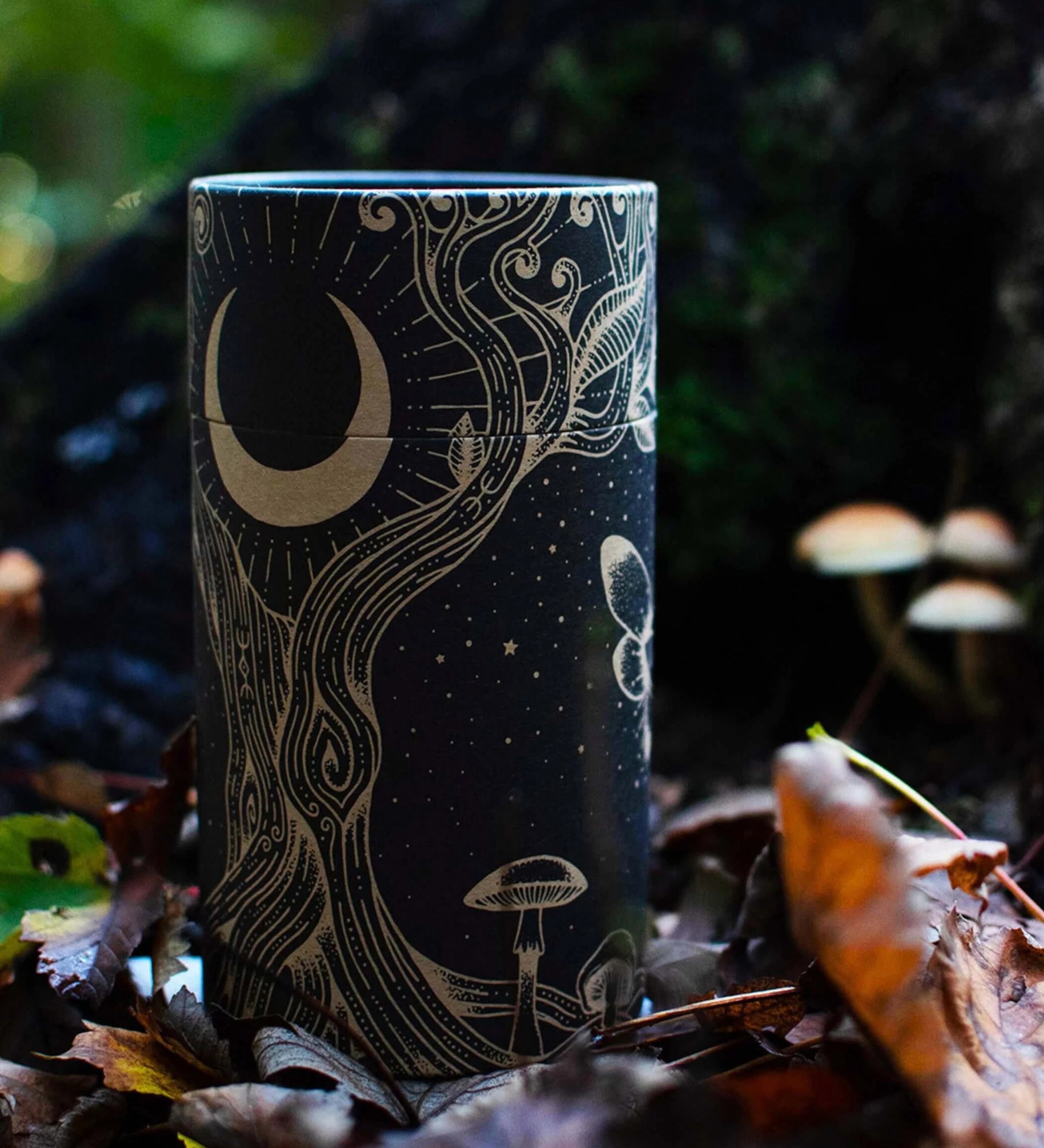Glycine: The perfect substitute for sugar

In our forest cocoa we use, among other things, the amino acid glycine to sweeten it. We would like to explain to you why we decided to do this:
What is Glycine?
Glycine performs an amazing number of essential tasks in the body. That's why the smallest of all amino acids is produced by the body itself (that's why it's called "non-essential"), but in some well-documented studies, external intake seems to have had strikingly positive effects on health. ( 1.-4. ) Glycine is the primary amino acid of collagen , the substance that tightens our skin and keeps joints and tendons supple.

How does glycine work?
- has preventive properties on factors contributing to atherosclerosis
- Improves sleep quality: Falling asleep faster, deeper sleep phases and reduced daytime tiredness
- Improves the regeneration of the skin, muscles, ligaments, vascular walls & more
- Promotes hormonal balance in men and women
- showed rejuvenating effects in cells in vitro
- protects against increased blood pressure by regulating fatty acid oxidation
Is external intake of glycine even necessary?
Since our body only produces 1g of glycine per day on average, a review of 74 studies from 2017 ( 1. ) suggests that there could be a weak point in the human metabolism: its capacity for glycine synthesis is apparently not sufficient to cover the body's own needs. The fact that in modern society, with the exception of very small amounts of gelatin, perhaps from gummy bears, foods that are particularly high in glycine or collagen, such as offal or tendons and cartilage, are no longer consumed, also supports this thesis. Without external intake, the human metabolism appears to lack an average of 10g of glycine per day. ( 2. )
Another argument in favor of external intake is found in a study from the Journal of Biosciences ( 3. ), which shows that additional glycine taken can pass the blood-brain barrier (Simply put, this is a main criterion for the fact that an ingested glycine Agent “arrives” at all) and glycine absorbed in this way regulates neurotransmission in the central nervous system. ( 3. )
What effect does glycine have on the psyche?
To understand this you have to start a little further. Surely each of you has heard of neurons, synapses and neurotransmitters. A chemical synapse does not simply transmit electrical signals but “modulates” them. Ie it regulates how a signal should be passed on. Glycine now acts as an “inhibiting” neurotransmitter. In very simple terms, this means that the signal is transmitted weaker and made “quieter”. This becomes noticeable when you relax, your stress level decreases and you sleep better.
Glycine is used in the synapses primarily to regulate neuronal activity. ( 3. )

Structure and functionality of a synapse
“The NMDA receptor with glutamate and glycine causes synapses to be remodeled. At the body level, it can be noted that this remodeling causes the synapses to interact more strongly with each other. This means that glycine and glutamate help form learning ability and long-term memory through the NMDA receptor. The conversion often takes place in the hippocampus and cerebrum and thus has a direct influence on memory.”
Glycine affects hormone balance
Glycine also ensures an increase in the release of the hormone GNRH ( gonadotropin-releasing hormone) in the hypothalamus ( 5. - 6. ), which in turn increases the release of the fertility hormones LH (luteinizing hormone) & FSH (folicle-stimulating hormone) (or interstitial cell-stimulating hormone). hormone (ICSH) in men) into the bloodstream.
More fertility hormones mean better hormonal balance in men and women. LH is a precursor to testosterone and, together with FSH, stimulates follicle formation in women. This study ( 6. ) shows the direct influence of external glycine on hormone secretion.
Improve sleep quality through glycine
Furthermore, glycine can improve the time it takes to fall asleep and the quality of sleep due to its inhibitory effect. When taken an hour before bedtime, body temperature also decreased. This contributes significantly to the quality of sleep. In addition, reduced daytime sleepiness was observed (7th - 15th)
Glycine regenerates and nourishes the skin
The body's largest organ also benefits from the amino acid. It supports moisturizing the skin and regenerates the cells of the epidermis. Glycine also prevents wrinkles and is involved in the production of elastin and collagen. (16th-17th)

Glycine and its effect on endothelial cells, atherosclerosis and nitric oxide
Atherosclerosis is the number 1 cause of death worldwide.
Glycine significantly reduces many factors that contribute to arteriosclerosis. This effect is due to the fact that glycine can remodel the endothelial cells of the artery walls ( 18. ) and increases the ability to absorb nitric oxide ( 19. )

Endothelial cells, arteriosclerosis and nitric oxide
The cells in the inner walls of our vessels are called endothelium . They have the important task of relaxing or contracting our vessels. One of the tools for this is nitric oxide . Its release also prevents the white blood cells from depositing on the vessels, which is the first stage of arteriosclerosis.
Nitric oxide has a vasodilating effect, lowers blood pressure and increases the oxygen content in the blood.
It is produced by the endothelium and is a messenger molecule that tells the blood vessel to dilate or expand and contract or relax. As we age, the endothelium produces less and less nitrogen, so the cardiovascular system becomes less elastic and reduces the flow of oxygen-rich blood to vital organs.
Foods that are rich in nitrate (which is biologically converted into nitrogen monoxide ) can also counteract this to some extent, especially one of our favorite “biohacks” beetroot juice. So now we know why it is extremely important to have good nitrogen absorption and a healthy endothelium.
"Glycine placed under the tongue may therefore also help limit brain damage caused by an ischemic stroke if given within 6 hours of the stroke . Ischemic shock is caused by the blockage of a blood vessel in the brain." ( 25. )
Glycine regulates the intestines
Similar to the endothelium of blood vessels, glycine also naturally contributes to the health of the epithelium in the intestine. The important so-called “ tight junctions ” (see picture) are regulated by glycine and maintain the barrier function . If something is not coordinated correctly, it quickly becomes noticeable in a variety of ways: fatigue, immune deficiency, immune overreactions, even depression can be triggered here.
This ( 27. ) study tested the hypothesis that glycine may regulate the expression and distribution of tight junction (TJ) proteins and thereby contribute to the barrier function of the intestinal mucosa.

The effect of glycine on insulin, diabetes & intestinal hormones
Glycine also increases insulin sensitivity in healthy people and in type 2 diabetics (36.) by stimulating the release of gut hormones such as GLP-1. GLP-1 has the ability to lower blood sugar levels by increasing insulin secretion. In addition to the insulinotropic effect, GLP-1 is also associated with numerous regulatory and protective effects.
How glycine affects the psyche
Tight junctions are found not only in the intestines but wherever there is a barrier in the body. One of the most important barriers is the blood-brain barrier . In a study by Trinity College in Dublin ( 34. ), it was shown that malfunctions of the tight junctions at this point can result in serious psychological disorders (depression, schizophrenia, etc.).
Aside from that, glycine also has a direct effect on the brain. Due to the previously mentioned inhibitory properties in the synapses, glycine can be used, for example, to cope with stress.
It reduces the restlessness of hyperactive nerves and leads to an optimization of neuromuscular control.
What happens when glycine can no longer develop its effect can be seen, for example, in the tetanus bacterium. Its toxins inhibit the release of glycine and lead to permanent excitation of the muscle. That’s why it’s also called “tetanus”.
Glycine and fat loss
Glycine also increases fatty acid oxidation and reduces intra-abdominal fat accumulation and " non-esterified fatty acids " circulating in the blood. These are considered for the link between obesity and high blood pressure. ( 35. )
Glycine protects the liver
Furthermore, it has been shown that glycine has an enormous influence on the regeneration of Kupffer cells in the liver and can thus reverse moderate liver damage. It protects against alcohol and inhibits liver inflammation. (36.)
What are Kupffer cells?
Did you know that 80% of all macrophages (the most important workers in the immune system) are located in the liver? Here they neutralize all bacteria, foreign substances and toxins that enter the body via the intestines and portal veins . Or at least they should. Because these are exactly the cells that are immensely attacked by alcohol consumption, for example. In one study ( 37. ), these cells could be almost completely regenerated by external supply of glycine.
Glycine is an elementary component of creatine synthesis
Glycine is also involved in the body's own creatine synthesis . Creatine is often known from the muscles in the gym and is primarily associated with excessive water requirements. What sounds borderline at first is actually produced naturally by your own body and takes on important functions. Creatine is also extremely interesting cognitively . It is a fairly strong nootropic , so it can increase cognitive performance. Since the body's own production is heavily dependent on glycine ( 41 ), deficiency symptoms also arise if there is insufficient intake.
Glycine is a basic building block for life
Glycine is one of the most original amino acids, and existed in protogas clouds long before stars and planets existed. It has also been found on comets and meteorites, such as the famous Murchison meteorite. According to one theory, the origin of life on Earth came from a meteorite impact on the prehistoric Earth. Glycine is one of the most important amino acids and a fundamental building block for life.
Glycine could rejuvenate cells
Promising discoveries were made in a study at the National Institute of Arthritis and Metabolic Diseases in Bethesda in the USA ( 39. ), in which human cells were shown to rejuvenate in vitro after glycine administration. That doesn't mean anything for real people, but it's definitely reason enough to mention it here.
That beats classic sugar by far, right?
Glycine can not only neutralize the negative effects of sugar but can even reverse them ( 40. )
a note:
In this article I provide information about the biochemical mechanisms in the body that are influenced by the amino acid glycine. I am neither a biochemist nor a doctor, just a curious person with a penchant for science. To the best of my knowledge, I provide information here that I have compiled through my own research. I have ensured that the studies I refer to were conducted properly, did not give rise to conflicts of interest and met the scientific gold standard. I'm writing this because I know that it's easy to become over-enthusiastic about nutritional supplements when an article simply explains their function in the body. As with everything, it is not a miracle cure . -Robin
Sources:
External recording makes sense
-
https://pubmed.ncbi.nlm.nih.gov/28337245/
Multifarious Beneficial Effect of Nonessential Amino Acid, Glycine: A Review
-
https://pubmed.ncbi.nlm.nih.gov/20093739/
A weak link in metabolism: the metabolic capacity for glycine biosynthesis does not satisfy the need for collagen synthesis
-
https://pubmed.ncbi.nlm.nih.gov/8146214/
E xogenous glycine passively diffuses across the blood-brain barrier and modulates neurotransmission in the CNS
-
https://pubmed.ncbi.nlm.nih.gov/3703107/
Antagonism of phencyclidine-induced hyperactivity by glycine in mice
Hormone balance
-
https://pubmed.ncbi.nlm.nih.gov/2541362/
Direct activation of gonadotropin-releasing hormone secretion through different receptors to neuroexcitatory amino acids
-
https://pubmed.ncbi.nlm.nih.gov/6788658/
Effects of glycine on serum gonadotropins and estradiol and on concentrations of free amino acids in the middle hypothalamus in female rats
Sleep quality
-
https://pubmed.ncbi.nlm.nih.gov/1726063/
A glycinergic projection from the ventromedial lower brainstem to spinal motoneurons. An ultrastructural double labeling study in rat
-
https://pubmed.ncbi.nlm.nih.gov/2926479/
Evidence that glycine mediates the postsynaptic potentials that inhibit lumbar motoneurons during the atonia of active sleep
-
https://pubmed.ncbi.nlm.nih.gov/16891059/
Brainstem glycinergic neurons and their activation during active (rapid eye movement) sleep in the cat
-
https://pubmed.ncbi.nlm.nih.gov/22529837/
The effects of glycine on subjective daytime performance in partially sleep-restricted healthy volunteers
-
https://link.springer.com/article/10.1111/j.1479-8425.2006.00193.x Subjective effects of glycine ingestion before bedtime on sleep quality
-
https://link.springer.com/article/10.1111/j.1479-8425.2007.00262.x
Glycine ingestion improves subjective sleep quality in human volunteers, correlating with polysomnographic changes
-
https://www.ncbi.nlm.nih.gov/pmc/articles/PMC3328957/
The Effects of Glycine on Subjective Daytime Performance in Partially Sleep-Restricted Healthy Volunteers
-
https://www.ncbi.nlm.nih.gov/pmc/articles/PMC4397399/#bib28
The Sleep-Promoting and Hypothermic Effects of Glycine are Mediated by NMDA Receptors in the Suprachiasmatic Nucleus
-
https://pubmed.ncbi.nlm.nih.gov/21949857/
Orexin neurons receive glycinergic innervations
Skin tightening
-
https://pubmed.ncbi.nlm.nih.gov/31905705/
Food-Derived Collagen Peptides, Prolyl-Hydroxyproline (Pro-Hyp), and Hydroxyprolyl-Glycine (Hyp-Gly) Enhance Growth of Primary Cultured Mouse Skin Fibroblast Using Fetal Bovine Serum Free from Hydroxyprolyl Peptide
-
https://www.ncbi.nlm.nih.gov/pmc/articles/PMC3351609/
Importance of amino acid composition to improve skin collagen protein synthesis rates in UV-irradiated mice
arteriosclerosis
-
https://pubmed.ncbi.nlm.nih.gov/33117340/
Atherosclerosis Linked to Aberrant Amino Acid Metabolism and Immunosuppressive Amino Acid Catabolizing Enzymes
-
https://pubmed.ncbi.nlm.nih.gov/22415010/
Deficiency of glycine N-methyltransferase aggravates atherosclerosis in apolipoprotein E-null mice)Plasma Glycine and Risk of Acute Myocardial Infarction in Patients With Suspected Stable Angina Pectoris
-
https://www.ncbi.nlm.nih.gov/pmc/articles/PMC4859380/
Glycine helps prevent factors that initiate atherosclerosis. Improves ability to use nitric oxide.
-
https://pubmed.ncbi.nlm.nih.gov/16720430/
The amino acid glycine modulates immunological response and enhances the production of endothelial derived nitric oxide (EDNO) factor.
-
https://pubmed.ncbi.nlm.nih.gov/11961027/
Vasodilatory N-methyl-D-aspartate receptors are constitutively expressed in rat kidney
-
https://pubmed.ncbi.nlm.nih.gov/15242825/
Protein intake regulates the vasodilatory function of the kidney and NMDA receptor expression
-
https://pubmed.ncbi.nlm.nih.gov/7843755/
Renal effects of acute amino acid infusion in hypertension induced by chronic nitric oxide blockade
- https://pubmed.ncbi.nlm.nih.gov/10629347/
Gusev EI, Skvortsova VI, Dambinova SA, et al. Neuroprotective effects of glycine in the treatment of acute ischemic stroke. Cerebrovasc Dis 2000
Glycine effect intestinal
-
https://pubmed.ncbi.nlm.nih.gov/26528128/
Breaking down the barriers: the gut microbiome, intestinal permeability and stress-related psychiatric disorders
-
https://pubmed.ncbi.nlm.nih.gov/27029941/
Glycine Regulates Expression and Distribution of Claudin-7 and ZO-3 Proteins in Intestinal Porcine Epithelial Cells -
https://www.ncbi.nlm.nih.gov/pmc/articles/PMC6021736/
Gelatin versus its two major degradation products, prolyl‐hydroxyproline and glycine, as supportive therapy in experimental colitis in mice
-
https://pubmed.ncbi.nlm.nih.gov/27491067/ Transferring the blues: Depression-associated gut microbiota induces neurobehavioral changes in the rat (2016 Journal of psychriatic research)
-
https://pubmed.ncbi.nlm.nih.gov/16945350/
Antidepressant-like effects of the histone deacetylase inhibitor, sodium butyrate, in the mouse
- https://onlinelibrary.wiley.com/doi/abs/10.1002/ibd.20068
Psychological treatment may reduce the need for healthcare in patients with Crohn's disease
Glycine effect psyche
-
https://pubmed.ncbi.nlm.nih.gov/15021249/
Serine deficiency syndromes
-
https://pubmed.ncbi.nlm.nih.gov/11939124/
Glycine: a cell-protecting anti-oxidant nutrient
-
https://pubmed.ncbi.nlm.nih.gov/10698962/
Glycine-gated chloride channels in neutrophils attenuate calcium influx and superoxide production
-
https://pubmed.ncbi.nlm.nih.gov/33139732/
Blood-brain barrier associated tight junction disruption is a hallmark feature of major psychiatric disorders
Fat oxidation
-
https://pubmed.ncbi.nlm.nih.gov/15331379/
Glycine intake decreases plasma free fatty acids, adipose cell size, and blood pressure in sucrose-fed rats
Effect on the liver
-
Zhong, Zhi et al.
L-Glycine: a novel antiinflammatory, immunomodulatory, and cytoprotective agent.
-
https://pubmed.ncbi.nlm.nih.gov/16101730/
Benefit of Kupffer cell modulation with glycine versus Kupffer cell depletion after liver transplantation in the rat: effects on postischemic reperfusion injury, apoptotic cell death graft regeneration and survival
Therapy for diabetes
-
https://pubmed.ncbi.nlm.nih.gov/29094215/
Insulin resistance and glycine metabolism in humans
Rejuvenating effects
-
https://www.nature.com/articles/srep10434
Epigenetic regulation of the nuclear-coded GCAT and SHMT2 genes confers human age-associated mitochondrial respiration defects
Miscellaneous
-
https://pubmed.ncbi.nlm.nih.gov/15331379/
Glycine intake decreases plasma free fatty acids, adipose cell size, and blood pressure in sucrose-fed rats
- https://pubmed.ncbi.nlm.nih.gov/21387089/
The metabolic burden of creatine synthesis
0 comments







